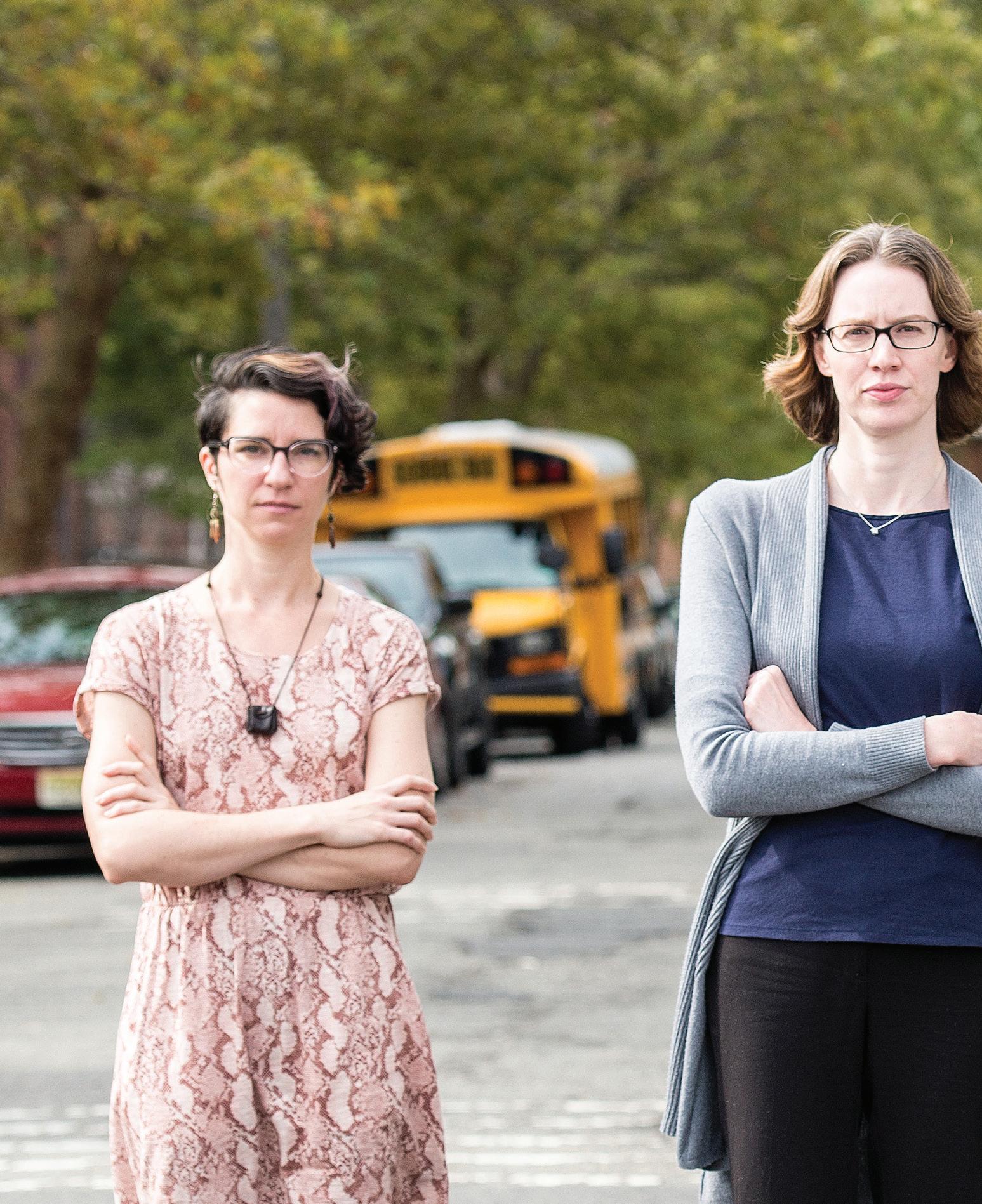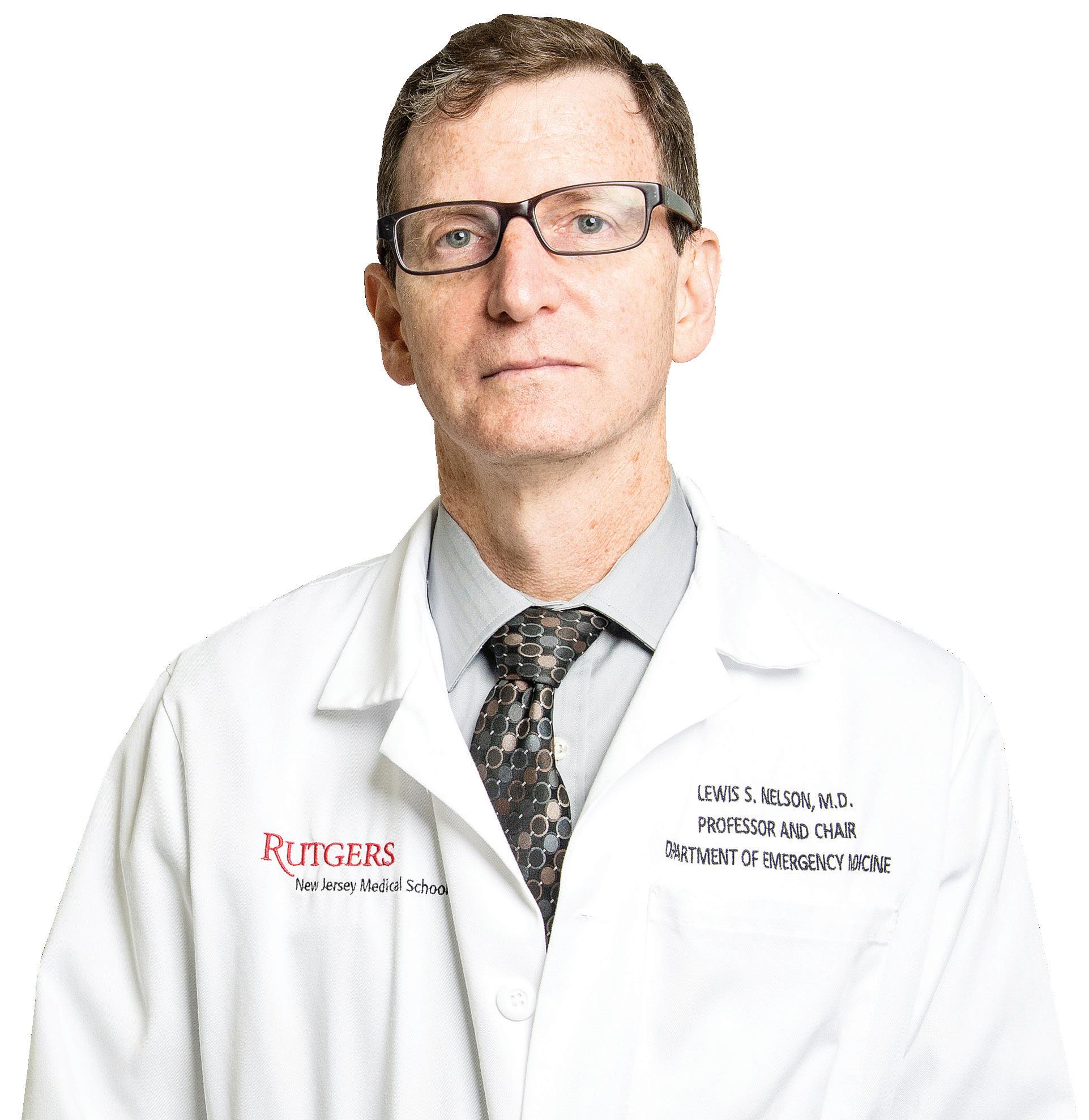
7 minute read
On the Frontlines of The Opioid Epidemic
On the Frontlines of the Opio id E pidemic

A multidisciplinary approach to fighting opioid use disorder, left to right: Lindsay Fox, MD (emergency medicine), Erin Zerbo, MD (psychiatry), Amesika Nyaku, MD (medicine), and Joshua Taffet, LCSW (psychiatry)
Battalion of NJMS doctors leads mission to treat and train

When Petros Levounis, MD, MA, considers the opioid crisis that has bedeviled the U.S. over the last three decades, what goads the psychiatrist and venerated addiction specialist is not just the toll that the epidemic has taken on New Jersey: The careers derailed; the families fragmented; the communities upended. The deaths. It’s the fact that, despite the havoc these drugs have already inflicted, newer, more potent opioids are being developed practically every day, harming vulnerable communities across the country. It’s one of the worries that keeps him up at night.

Dr. Petros Levounis
Chair of Psychiatry, Rutgers New Jersey Medical School
But Levounis, chair and professor of psychiatry, doesn’t let worry impede his work. He and a battalion of NJMS physicians from multiple specialties have joined forces to battle this crisis, providing state-of-the art treatment; training students and other health care professionals; and developing statewide collaborations to get ahead of this scourge and stymie its effects. MAT: A Silver Bullet “This is truly a landmark epidemic,’” says Erin Zerbo, MD, an addiction specialist and NJMS assistant professor of psychiatry. “This crisis is in everybody’s backyard. It’s in all our lanes.” She points out that some physicians are reluctant to treat patients with opioid use disorder. But what they don’t realize is that “these patients are already in their waiting rooms. They’re just not talking to their doctors about it.” Helping physicians understand the neurobiology behind addiction—where the prefrontal cortex, which controls complex cognitive and social behaviors, is weakened, while the primitive part of the brain becomes stronger, causing people to act out compulsively—allows them to see addiction not as a moral weakness but as a chronic illness for which effective treatments exist.
Among the gold standard of therapies is MedicationAssisted Treatment, or MAT. A powerful weapon against relapse and overdose, MAT combines counseling and behavioral therapies with medications, such as buprenorphine, methadone, or naltrexone to treat patients. “MAT drastically reduces mortality,” says Zerbo, who also runs the Comprehensive Addiction Resources and Education (CARE) Center, a low-barrier clinic that provides MAT without imposing onerous counseling requirements. “In terms of a silver bullet, we have it in MAT.” The most popular MAT is buprenorphine, a Schedule III Controlled Substance. Approved for maintenance treatment of opioid use disorder since 2002, it can be prescribed from an office-based setting. Long-lasting and slow-onset like methadone, buprenorphine allows the brain to heal. And if a patient has a relapse, it dramatically reduces the high, Zerbo says, adding, “They’ll use it and think, ‘I barely felt anything. I just wasted my money.’” Meanwhile, she notes, they’re unlearning the behavior, while maintaining their tolerance; thereby dramatically reducing their chance of an opioid overdose death.
As effective as buprenorphine is, there remains an access issue linked not only to stigma, but also to federal restrictions like the Drug Abuse Treatment Act of 2000 (DATA 2000), which requires doctors to obtain waivers to prescribe buprenorphine. Additionally, the lack of a robust federal framework to combat the epidemic means each state must devise its own plan of attack, says Zerbo. In January, New Jersey Gov. Phil Murphy unveiled several initiatives in response to the spate of drug overdoses in the state. Among them was providing funding for two new centers of excellence for opioid treatment: one at NJMS and the other at Cooper Medical School of Rowan University (CMSRU). Established in April with a $2 million grant from the NJ Division of Medical Assistance and Health Services, the Northern New Jersey Center of Excellence in Medication-Assisted Treatment (NNJ-COE-MATrx) is led by Zerbo along with NJMS assistant professors Amesika Nyaku, MD, MS, (Department of Medicine); Lindsay Fox, MD, (Department of Emergency Medicine); and Emily Gordon, MD, (Department of Medicine); as well as mental health clinician Joshua Taffet, LCSW.
Prevention of addiction…is a much better approach than treating it. - Lewis Nelson, MD
Covering 12 counties, the center’s goal is to increase patients’ access to MAT and support services in northern New Jersey and provide mentorship and consultative support to DATA-2000-waivered physicians and prescribers. The center has hired staff and created a MAT Provider Hotline in collaboration with the other center at CMSRU, supplying real-time advice for providers. Model Curriculum NJMS has implemented several educational programs to train students and doctors to battle this crisis. Following the creation of a Pain Management and Analgesic Prescribing Curriculum Workgroup led by Sangeeta Lamba, MD, associate dean for education; Levounis; and Lewis Nelson, MD, professor and chair of emergency medicine, NJMS last year became one of the first medical schools in the country to require all students to receive training necessitated by DATA 2000. Third-year students take the school’s eight-hour course and learn about alternative treatments for acute and chronic pain and safe opioid prescribing. Through this course, NJMS, “is becoming a model for other medical schools on how to incorporate buprenorphine courses into their curriculum,” says Levounis. Other educational programs at NJMS include:
• A series of buprenorphine-waiver certification sessions—made possible through a $1 million grant from the NJ Division of Mental Health and Addiction Services—where physicians, physician assistants, and advanced practice nurses learn how to prescribe buprenorphine.
• A one-year Fellowship in Addiction Medicine, which trains fellows to evaluate and treat patients with substance use disorders, behavioral addiction, and co-occurring psychiatric disorders. The fellows rotate on clinical services at University Hospital (UH), the Veterans Affairs New Jersey Health Care System, and Rutgers University Behavioral Health Care. • ECHO (Extension for Community Healthcare
Outcomes), a model program that educates primary care providers (PCPs) in the treatment of substance use disorders. Through this program, NJMS doctors consult with New Jersey PCPs via video conference.

Dr. Lewis Nelson
One-Stop Shopping As an internist, Gordon sees firsthand how substance use disorders affect patients’ overall health. “Substance use disorders exacerbate many of the medical conditions we treat,” she notes. For this reason, the Department of Medicine’s Primary Care Clinic provides prescriptions for buprenorphine. Having more PCPs available to handle these cases is vital to overcoming this crisis, Gordon says. “We have to meet the patients where they’re at. When they come to their heart failure appointments, that’s where we need to talk to them about their substance use.”
This “one-stop shopping” approach has been implemented in several other NJMS faculty practices, including the Healthy Beginnings Obstetrics/Gynecology Clinic run by Department of Obstetrics, Gynecology and Women’s Health’s Damali Campbell-Oparaji, MD, assistant professor, and Natalie Roche, MD, associate professor. “People have so many responsibilities: working multiple jobs; taking parenting classes; dealing with the judicial system,” says Campbell-Oparaji. “So providing care in one place is very helpful.” Campbell-Oparaji and Roche are involved in the Addiction Consultation Service at UH, which provides consultations for patients— female and male—with substance use disorders. Additionally, Roche helped start an Addiction Workgroup at NJMS, a multispecialty team of physicians from psychiatry, emergency medicine, obstetrics/ gynecology, infectious diseases, internal medicine, medical toxicology, pain management, pediatrics, and surgery. “We’re providing really good coverage with different specialists working together to address substance use disorders,” Roche says. At UH’s emergency department (ED), which sees three to five overdoses a day, a comprehensive approach assists patients with substance use disorders, says Nelson.

“We’re able to initiate people on buprenorphine treatment while they’re in the ED. When they’re stable to leave, we provide them with a buprenorphine prescription and a referral to our CARE center.” To ensure that people make it to their appointments, adds Fox, the ED is hiring peer navigators—individuals with personal experiences with addiction. Made possible through a $1.5 million grant from the federal Substance Abuse and Mental Health Services Administration, the navigators will be trained to walk patients through the process of getting addiction treatment and services. “Bringing individuals with lived experience with addiction onto our team may help decrease the stigma around addiction and addiction treatment,” Fox says. One thing the HIV epidemic has taught Nyaku is that there’s hope. “HIV has gone from being a death sentence to a chronic condition that can be managed. People can be healthy and have near-normal life expectancies,” says Nyaku. She works at NJMS’s Infectious Diseases Clinic, where impressive reductions have been seen in the viral loads of buprenorphine-maintained HIV patients. “Similarly, regarding the opioid crisis, one of the most impressive things is knowing what we can do when we have political will, funding, providers, and community engagement.”
Prevention According to the New Jersey Poison Control Center, which is overseen by the NJMS Department of Emergency Medicine, the opioid epidemic started in 1991 when deaths involving opioids began to rise following a sharp increase in the prescribing of opioid and opioid-combination medications for the treatment of pain. That this crisis is, in part, iatrogenic—i.e., induced inadvertently by medical treatment— makes Nelson uneasy. But it’s not surprising, considering how doctors were once trained, he says. “In medical school, I was told that there’s no dose of opioid that’s too great. You give whatever it takes to relieve the pain. That was 30 years ago.”
Truth is, says the renowned medical toxicologist, “We have pain for a reason. Pain reminds us not to do things that are causing damage.” To help avoid addiction, altogether, Nelson’s department has implemented guidelines that establish a “hierarchical approach” to pain management. For example, says Nelson, “We’ll start with Tylenol and if that doesn’t work, we’ll go to Motrin and if that doesn’t work, we’ll go to a different class of drugs.” Bottom line, Nelson says: “Prevention of addiction … is much better than treating it.”
Get the student perspective on the opioid epidemic with Kishan Shah, fourth-year medical student at issuu.com/rutgersnjms.
Levounis (left) and Zerbo (right) trained health care providers throughout the state on the use of buprenorphine to treat opioid dependence.

